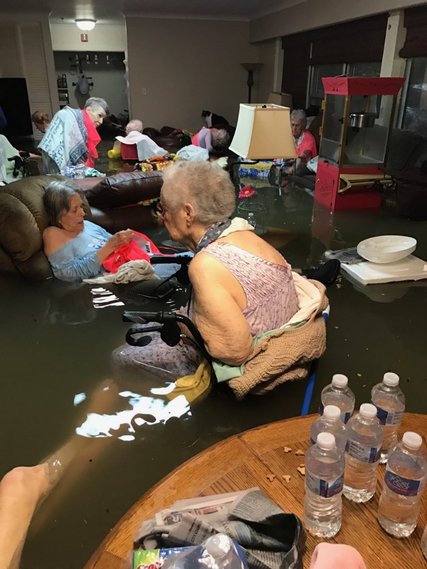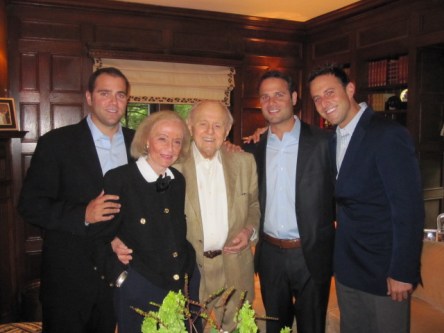The pandemic has brought change to senior living like nothing else before it. But through it all, the industry’s commitment to care has never wavered. In fact, many caregivers have gone above and beyond to keep their residents healthy and happy. In honor of these heroes, NCAL has announced “Caring Is EssentiAL” as the theme for this year’s National Assisted Living Week, set for September 13 -19. Established in 1995, National Assisted Living Week provides an opportunity for residents, loved ones, staff and the broader community to recognize the role of assisted living in helping seniors and those with intellectual disabilities. By encouraging senior living providers nationwide to host special events and activities all week long, NCAL plans to celebrate residents and caregivers together as well as educate the public about long-term care. The annual observance will have to adapt to COVID-19 restrictions this year, but despite the hurdles, the staff of senior living deserve to be recognized for their incredible work. And although the event many not look quite the same on the surface, the spirit of celebration will still be there. Socially distant activities for National Assisted Living Week Each year, NCAL puts out a planning guide for National Assisted Living Week with event ideas to inspire providers. This time around the suggestions focus on ways to have fun even with the extra safety protocols in place. Here’s a quick rundown of what they recommend: Celebrations: Try an end-of-summer ice cream delivery, schedule a family car parade and get creative with a dress-up day. Music: Host a hallway singalong, invite musicians among the community to share their gifts or stream a recorded concert. Exploration: Encourage virtual museum visits, share live webcams of zoo animals and “tour” favorite destinations through photos. Connections: Organize...
CALA Conference
Assisted Living Industry Meets
If you’re attending the California Assisted Living Association (CALA) 2018 Spring Conference & Trade Show, along with 800 other professionals who will engage in important issues and explore opportunities for the assisted living industry, Yardi is excited to see you there. With the theme “elevate,” to acknowledge that senior living professionals are continually seeking ways to improve and enhance their services, the event is set for June 4-6 at the Hyatt Regency Sacramento and Sacramento Convention Center in California. Assisted living, memory care and continuing care resident community operators come together at CALA’s spring conference to participate in active learning, engage in critical discussions, and hear from outstanding presenters with a broad range of expertise within and outside the profession. Sessions will cover resident and dementia care knowledge and practices, legal and regulatory awareness, leadership and staff culture along with sales and marketing strategies. Attendees expect to walk away with ready-to-use information, ideas, and best practices that both challenge and inspire them. In addition to not-to-be-missed educational sessions, the conference also provides networking and socializing opportunities including a wine tasting event on Monday, June 4 and a cocktail reception on Tuesday, June 5. Yardi is sponsoring the luncheon general session on Wednesday, June 6 at 12:15, where featured speakers Matthew Emerzian and Cindy McCann will discuss “Creating a ‘You Matter’ Culture” that touches both residents and employees in assisted living organizations. View complete details about the luncheon, speakers and sessions in the conference brochure. While exploring the trade show exhibitors, you’re invited to discover Yardi’s single connected solution for senior living by visiting Booth 50, and while you’re there, enter for a chance to win a Bose Bluetooth Speaker. We look forward to meeting you in...
Seniors + Safety
Hurricane Harvey
Viral photo of flooded assisted-living facility in Houston demonstrates importance of disaster preparedness for senior living communities. With so many heartbreaking images of the devastation visited upon Houston by Hurricane Harvey, the photo of residents of the La Vita Bella assisted-living center in Dickinson stands out. The photo, which depicts several seniors submerged in murky, waist-high flood waters, triggered outrage after gaining widespread attention on Twitter and other social media outlets. By Sunday afternoon, an evacuation was underway, with all the eventually relocated to a nearby nursing home. With a new photo of the now safe and dry residents now making the rounds online, questions still linger regarding the delay in emergency services, with some of the resident’s family members telling CNN they were forced to post the photo on Twitter in an attempt to trigger a rescue effort. “They were basically told no one was coming because they couldn’t reach them,” Kim McIntosh, mother of resident Trudy Lampson, told CNN. “That’s when we decided to go ahead and tweet the photos.” Preparing For Disaster While the situation at La Vita Bella is, hopefully, an extreme example, the catastrophe triggered by Hurricane Harvey serves as yet another reminder of the importance of disaster preparedness. As Jay Shelton, Senior Vice President, at Assurance Risk Management, writes in a December 2015 issue of Senior Housing Business, “The best time to write one of these plans is, frankly, yesterday.” “Without prior planning, you leave your organization open to financial disaster,” he continues, “especially if you are forced to close operations for a period of time. In addition, without a proper plan to cope with a disaster, your facility may face lawsuits from vendors, employees or residents’ families claiming negligence.” Prioritize and Delegate When developing an emergency preparedness...
Cultural Concerns
Aging Demographics
Expected to command a significant portion of America’s aging population over the next several decades, the nation’s aging Hispanic population will usher in a new era of cultural needs and expectations. That’s according to a new study commissioned by the Associated Press-NORC Center for Public Affairs Research. After surveying older Hispanics on their attitudes and expectations regarding assisted living and senior housing, researchers concluded Hispanics might “face additional obstacles in getting culturally competent care.” “…49 percent of older Hispanics have already faced language or cultural barriers as they navigate the health care system,” state the report’s authors. “These barriers have resulted in additional stress, delays in getting care, increased time and effort, not getting needed care and higher than expected costs for care.” Respect and Value Expressing feelings of frustration, loneliness and confusion, the survey’s participants expressed concern over the ability of their local health care providers to meet their specific needs. Specifically, respondents reported difficulty communicating with doctors and nurses due to language and cultural barriers. For those experiencing difficulty overcoming these challenges, two-thirds said they experienced additional stress and delays related to receiving adequate medical care. Unfortunately, less than half of the Hispanics surveyed expressed confidence in their local health care facilities and nursing homes’ ability to meet the needs of senior residents. Even fewer respondents felt home health aides and assisted living communities are up to the challenge, with only 20 percent of participants conveying they felt assured of the capabilities of their local home senior health providers. Complex Communications With almost 3 out of 4 Hispanics speaking Spanish in the home, the language barrier remains the foremost barrier to adequate senior care. According to the survey, a little more than a third of respondents reported speaking English “less than ‘very...
Kindness Rules
Senior Giving
To mark two decades in the senior care industry, Benchmark Senior Living recently embarked on a seven state mission to spread kindness and neighborly love in towns and neighborhoods where the company’s 54 senior living communities are located. For the month of June, residents living near a Benchmark community discovered care packages on their doorstep along with small helpful acts like a newspaper moved closer to their front porch, all with a note commemorating Benchmark’s “Radiant Acts of Kindness.” Employees committed to 1,000 such acts throughout the month. “This is Benchmark’s 20th anniversary year, and we want to give back to the communities and families that have supported our company’s growth since 1997,” Tom Grape, the company’s founder, and CEO said in a statement. “So, every one of our 54 senior living communities across seven Northeast states — and our home office in Waltham, Mass., — has committed to performing at least 20 Radiant Acts of Kindness during June in their local neighborhoods and towns.” Located in Waltham, Mass., Benchmark Senior Living operates 54 senior living communities throughout the Northeast. They offer services ranging from independent living to skilled nursing and memory care. For the last nine years, Benchmark has been recognized by The Boston Globe as one of the “Top 100 Places to Work,” and many of Benchmark’s executive directors and staff embraced the June initiative. Every one of Benchmark’s communities committed to the 1000 Acts, with many taking a creative approach that went beyond gift baskets to include washing cars, providing free tennis balls to neighborhood dogs to handing out random gift certificates. “We can’t wait to share these compassionate acts with West Chester and surrounding areas,” commented Doug Buttner, executive director, Wellington at Hershey’s Mill. “Our employees already have surprises prepared...
Keep Connected
National Assisted Living Week 2016
With its 2016 theme, Keep Connected, the National Center for Assisted Living hopes to shine a sotlight how technology can enhance the lives of senior citizens. According to a 2014 Pew report, almost 3/4th of American seniors own a cell phone, and more than half are online. In fact, though older adults are typically late adopters, Pew discovered that once seniors join the online world, “digital technology often becomes an integral part of their daily lives.” In recognition of the effect technology can have on the lives of older citizens, the National Center for Assisted Living (NCAL) announced the theme for National Assisted Living Week 2016 will be “Keep Connected.” Organizers hope the event, taking place September 11-17, will highlight how technology can improve the senior experience. “With this year’s theme, we hope to help overcome the mistaken belief that seniors are not interested in or able to learn about the latest modern advancements,” explains NCAL Executive Director Scott Tittle. “At the same time, we want to recognize the many revolutionary ways staff are enhancing care through new innovative tools and broadening their connections with the larger community.” For older adults transitioning into senior living, the physical distance from friends and family can be daunting. The disappearance of day-to-day contact with loved ones can leave retirees feeling isolated and alone, but that doesn’t have to be the norm. As programs like Sienna Senior Living’s Cyber Seniors prove, with a little coaching seniors can learn to use the latest apps and devices without difficulty. Laptops, phones and tablets empower older adults, helping to strengthen personal relationships and connect with us with the outside world. For senior living businesses using the Yardi Senior Living Suite™, the value of a connected community is evident. From the beginning,...
Silver Tsunami
Housing America’s seniors
America is in the midst of an unprecedented growth of the senior population. By 2030 there will be approximately 132 million individuals over the age of 50, the Joint Center for Housing Studies of Harvard University (JCHS) predicts. At the same time, one in five Americans will be 65 and over, with the 65-74 age group reaching 38.6 million, nearly double of what their numbers were in 2010. By 2040 every eighth American will be over the age of 75, while currently only one in sixteen is. All in all, in less than 20 years the 50+ generation will increase by 23 million. While there’s still time to plan for this unprecedented growth, communities, developers and policy makers need to implement long-term plans to safely and equitably accommodate America’s silver Boomers. The Silver Tsunami The silver tsunami, as some have dubbed the influx of aging Baby Boomers, started showing its force in the mid-nineties, when the oldest Baby Boomers hit 50. Between 1990 and 2010, the pre-retirement age bracket (50 to 64 years old) swelled from 32.5 million to 58.8 million. With the oldest Boomers steadily crossing 65 now, that growth will feed into the senior demographic, causing an unprecedented growth. Family makeup impacts senior housing needs. 47 percent of householders under the age of 50 have at least one child living in the home. For those over 50, that number drops to nine percent. The number of people living alone also increases steadily after 50. By age 80, three out of five households consist of a single person, and 75 percent of those are women. This in many cases leaves seniors and pre-retirees in oversized homes, which can be costly to maintain. Pre-retirees and seniors looking to downsize and/or move into some form of senior housing were hit especially hard during the economic downturn, as their home equity was locked up in a soft housing market. The recovering single-family market however, paired with a strengthening stock market has a lot of seniors feeling safer about their options, Marcus and Millichap found. Freeing home equity has allowed for more seniors to relocate funds towards senior housing such as continued care retirement communities (CCRC). A more stable economic environment is also allowing younger generations to dedicate funds towards specialized housing for senior parents. As a result, occupancy has grown across all senior housing segments: independent living occupancy is on the rise, and skilled nursing facilities are posting lower vacancies. Growing demand has also pushed up rents. The Affordable Care Act is also expected to help many seniors to access specialized care facilities. Seeking Senior-Friendly Housing As financial security and physical and cognitive abilities decrease with age, affordable, accessible and well-located housing becomes of utmost importance. Although quality of life in old age continues to improve, the increase in life expectancy also means that the number of adults living with some form of disability will also grow, at a time when most of the existing housing stock is ill equipped to cater to these needs. This birthed the universal design movement that aims to make built environments accessible and safe to individuals of all ages and abilities and allow for aging in place. According to JCHS, the five most important features of universal design are no-step entries, single floor living, extra-wide hallways and doors that allow for wheelchair access, switches and outlets reachable at any height and lever-style door and faucet handles. Only 57 percent of the existing housing stock incorporates at least two of these features. Although multifamily units built after 2000 are significantly more accessible than pre-1940 housing, most still lack the universal design quintuplet. For example, only one in five feature lever handles and only one in six has extra wide hallways and doors. Most adults over the age of 50 live in single family homes they own. Only a little over 60 percent of senior renter households...
Serving Seniors
Bloom Senior Living
There is both a touching family story and a caring resident focus in practice at the senior living residences operated by Yardi client Bloom Senior Living (f/k/a Bloomfield Senior Living), which operates senior care communities in Indiana, Ohio and South Carolina. Bloom’s parent company, Kandu Capital, LLC also owns independent senior residences in Southern California and Arizona, and has acquisitions pending in the Southeast. In the rapidly growing market for residential memory care services, the Bloom model is both personal and heartfelt. The approach may stem from the company’s history. Founder Richard Tischler, a hard-working family man who still comes to the office five days a week at age 98, built a nursing home business with the support of his late wife Ruth, who in her later life suffered from Alzheimer’s disease. Her illness, and the experience of finding a suitable living facility to meet her needs, had an immediate impact on the Bloom approach to care. With Richard’s two sons-in-law (Howard M. Dubin and Mitchell A. Kantor) and three grandsons (Bradley E. Dubin, Scott M. Kantor and Tony Kantor) involved in growing and efficiently operating the family’s seniors housing portfolio, the company strives for the highest quality care and a top-flight customer service experience. They want families and residents to find the type of residential experience, exceptional care and resulting peace of mind that they sought when Ruth Tischler became ill. She and Richard are considered the company’s “Chief Inspiration Officers,” a fitting title. “We went through the process of looking for (a care community) for her and seeing what was out there while we were doing our own search. We looked at it not just from the perspective of being an operator, but from being a family member. We stood in those...








